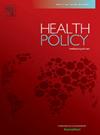The use of discrete choice experiments in evaluating telehealth: a systematic review
IF 3.4
3区 医学
Q1 HEALTH CARE SCIENCES & SERVICES
引用次数: 0
Abstract
Background
There is a growing body of evidence from discrete choice experiments related to telehealth. Discrete choice experiments offer valuable insights in informing the design and evaluation of telehealth services and supporting the telehealth implementation and policy.
Objective
This review aims to examine studies assessing consumer preferences for telehealth using discrete choice experiments.
Methods
A systematic review was conducted, searching five health and multidisciplinary databases from inception until 4 April 2024. Grey literature searches, hand-searching, and reference list checks were also performed.
Results
Of 2832 studies screened, 52 met the inclusion criteria. Most studies were conducted from the patient perspective (n=47/52, 90 %) and covered a wide range of populations and settings. Of the included studies eligible for quality assessment, 68 % (n=23/34) received high-quality ratings, while others were assessed as moderate. Studies comparing face-to-face consultations with telehealth generally found a preference for face-to-face appointments. Telehealth is viewed more favourably if it can be offered at a lower cost, reduces wait times, and is part of a comprehensive care plan. Telehealth tends to be preferred by younger patients and clinicians, those digitally literate, and those with less severe or more private and stigmatised health conditions.
Conclusion
While face-to-face consultations are generally preferred, telehealth is viewed as advantageous if it reduces costs, shortens wait times, and is integrated into comprehensive care. The findings highlight the importance of considering these attributes when designing telehealth preference studies and informing the adoption and design of telehealth services.
使用离散选择实验评估远程医疗:系统回顾
越来越多的证据来自与远程医疗相关的离散选择实验。离散选择实验为远程医疗服务的设计和评估以及支持远程医疗的实施和政策提供了宝贵的见解。目的本综述旨在通过离散选择实验来评估消费者对远程医疗的偏好。方法系统检索5个健康和多学科数据库,检索时间自成立至2024年4月4日。还进行了灰色文献检索、手工检索和参考文献列表检查。结果在筛选的2832项研究中,52项符合纳入标准。大多数研究是从患者角度进行的(n=47/52, 90%),涵盖了广泛的人群和环境。在纳入的符合质量评估的研究中,68% (n=23/34)获得高质量评级,而其他研究被评估为中等。比较面对面咨询和远程医疗的研究普遍发现,人们更倾向于面对面预约。如果远程保健能够以较低的成本提供,减少等待时间,并且是综合护理计划的一部分,那么远程保健就更受欢迎。较年轻的患者和临床医生、懂数字技术的人以及健康状况不太严重或比较隐秘和受歧视的人往往更喜欢远程保健。结论虽然面对面咨询通常是首选,但如果远程医疗能够降低成本、缩短等待时间并与综合护理相结合,则远程医疗被认为是有利的。研究结果强调了在设计远程医疗偏好研究和为远程医疗服务的采用和设计提供信息时考虑这些属性的重要性。
本文章由计算机程序翻译,如有差异,请以英文原文为准。
求助全文
约1分钟内获得全文
求助全文
来源期刊

Health Policy
医学-卫生保健
CiteScore
6.40
自引率
6.10%
发文量
157
审稿时长
3-8 weeks
期刊介绍:
Health Policy is intended to be a vehicle for the exploration and discussion of health policy and health system issues and is aimed in particular at enhancing communication between health policy and system researchers, legislators, decision-makers and professionals concerned with developing, implementing, and analysing health policy, health systems and health care reforms, primarily in high-income countries outside the U.S.A.
 求助内容:
求助内容: 应助结果提醒方式:
应助结果提醒方式:


